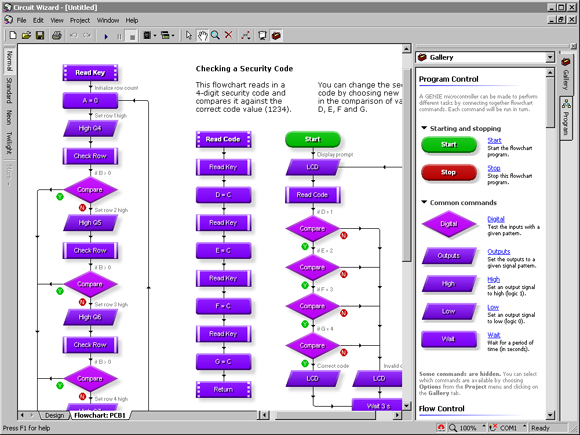|
Programming with
GENIE |
| GENIE is a programmable
system, which means that you can control how it
behaves by writing a computer program — and by
changing that program, you can turn GENIE's hand to solving
a whole
range of different design problems. |
| |
|
 A
programmable system A
programmable system
|
|
 |
|
|
|
| |
| At the heart of the GENIE system is the GENIE
microcontroller. |
|
This special type of electronic
component is what makes the GENIE system programmable.
It is able to take programs written on the computer and through a process known
as downloading, store them
in its memory. Once there, the GENIE microcontroller can
run the program to provide the intelligence to control
your
project.
|
|
| However, the GENIE microcontroller
will not work on its own. To function, it needs to be connected
to other things, such as a power supply, a socket
for connecting a cable, and whichever particular inputs and
outputs are required. |
| |
|
| |
| Collectively, these different parts
form what is known as an electronic circuit,
an example of which is shown above. It depicts a GENIE
08 Project Kit being
used as part of an embedded control system for a project.
This is
one of many different boards and kits that
we offer as part of the GENIE range. Each is tailored towards
different project applications,
with some better suited to controlling motors and
others focusing on sound and music or lighting, for example. |
We have worked hard to ensure
that with GENIE, whatever your project, there is a board or
kit that can help bring it to life! To learn more, click here.
Our latest, the GENIE 14 Audio Kit,
is particularly exciting as it offers opportunities for you
to add realistic
sound effects and high-quality 16-channel
MIDI music. Alarms, toys, robots and countless other
projects can be enhanced with GENIE. |
|
|
For those teachers or pupils with
in-depth knowledge of electronics wishing to create
their own programmable boards and kits, there is a brand
new range of GENIE microcontrollers that can be built into
custom circuit designs and layouts. |
|
| |
|
 Knowing
where to start Knowing
where to start
|
|
 |
|
|
|
As with all
forms of design, where you start will depend on the particular
design problem that you are attempting to solve. Sometimes
the behaviour of a control system may be known early on, and
at other times it may evolve slowly through further investigation
or feedback from end users.
At some point in the design process, though, you will be ready
to start planning the type of embedded control that your
project requires. You will need to consider:
|
|
 |
|
What inputs are required from
users or the environment? |
|
 |
|
What outputs do you want to produce? |
|
 |
|
How will these inputs and outputs be controlled by a program? |
|
|
|
Of course, with so many different input and output components
from which to choose, and such a wide array of possible
programming options, what you really need is an expert
on hand to guide you.
The Circuit Wizard 3 Resource Centre
is that expert; an extensive collection of resources fine-tuned
through decades of experience supporting teachers and students
with their design projects, it is our way of being there
in the classroom with you. |

|
|
| For teachers, the Resource Centre
acts as your own professional trainer, providing knowledge
and development that will inspire
confidence on topics that might well be new to you. Students
will also benefit by becoming motivated and self-sufficient
learners, discovering and investigating areas specific to their
own design projects. |
| |
|
| |
|
 Programming
with flowcharts or BASIC Programming
with flowcharts or BASIC
|
|
 |
|
|
To begin the process of actually
writing the computer program that will run on a GENIE microcontroller
and bring your project to life, you will require some special
software — either Circuit
Wizard 3 or the free GENIE Programming
Editor.
Which of these two software products is right for you will
depend on your level of expertise. The free GENIE Programming
Editor
is best
suited to those already confident with electronics and programming,
whereas Circuit Wizard 3 by contrast is aimed at those looking
for more assistance, through its in-built set of classroom
resources and
support for designing,
modelling and making.
Both Circuit Wizard 3 and the free GENIE Programming Editor
allow you to control the behaviour of a GENIE system in two
distinct
ways:
a graphical
flowcharting system
and a more powerful text-based BASIC programming language. |
|
GENIE Flowchart programming
If you are new to programming, or
just prefer a more graphical approach, then GENIE flowchart
programming is for you. With flowcharts, programs can be created
by selecting commands and then
linking them together with the mouse.
Because flowcharts are more visual there
is less for you to remember and fewer opportunities to make
mistakes. When selecting the options for a command, for
example,
the
software
will provide
a list of all the valid choices that are open to you.
|
| |
 |
| |
GENIE BASIC programming
For those with prior programming experience, we also allow
GENIE to be controlled through our own
special version
of
the BASIC
language.
Unlike the graphical flowcharts, BASIC is a text-based language,
which means that you enter commands by typing their names into
the computer along with any parameters that may be required
(such as the values to be used in a calculation).
Most computer programming languages work this way, and
so GENIE BASIC programming provides a stepping stone towards
the languages and concepts that will be covered in complementary
computing and technology courses. |
| |
 |
| |
|
|
|
|
